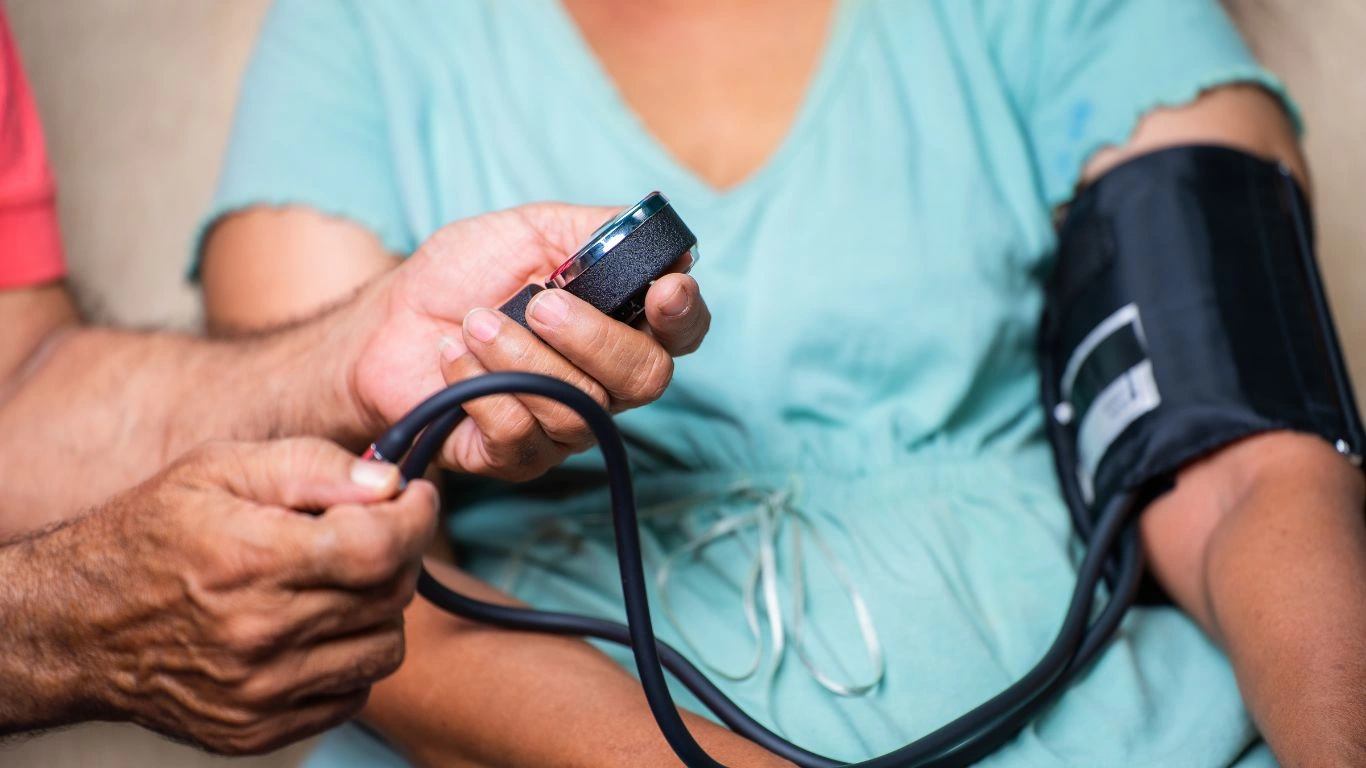Food Sensitivities & Blood Pressure: The Hidden Link You Can’t Ignore
Have you ever noticed that certain foods make you feel off? Maybe you feel bloated, sluggish, or even get a headache after eating something that never seemed like an issue before. But did you know that food sensitivities can actually impact your blood pressure? Yep, that’s right. As someone who has spent years working with patients managing hypertension, I’ve seen first-hand how food choices—especially hidden sensitivities—can send blood pressure soaring. And the worst part? Most people have no idea this is happening.
How Food Sensitivities Impact Blood Pressure

When people think about high blood pressure, they usually blame salt, stress, or genetics. While those are definitely factors, there’s another sneaky culprit: food sensitivities. Unlike full-blown food allergies (which can trigger severe reactions like anaphylaxis), food sensitivities are more subtle. They trigger chronic inflammation in the body, which, over time, can contribute to increased blood pressure. I’ve had patients who cut out their trigger foods and saw their numbers drop significantly—without medication. That’s powerful.
The Connection Between Inflammation and Hypertension
Here’s how it works: When you consume a food your body is sensitive to, your immune system perceives it as a threat. This leads to low-grade inflammation as your body tries to defend itself. Now, inflammation isn’t always bad—it’s part of the body’s natural defense system. But chronic inflammation? That’s where the problem begins.
Inflammation can lead to stiffened arteries, increased fluid retention, and heightened stress responses—all of which make blood pressure climb. The tricky part? Symptoms of food sensitivities can be so vague (fatigue, brain fog, bloating) that people don’t connect the dots to their hypertension.
Common Food Sensitivities That May Spike Your Blood Pressure

Over the years, I’ve seen patients react to all sorts of foods, but some culprits pop up more often than others. Here’s a list of common food sensitivities that may be silently raising your blood pressure:
- Dairy – Many people struggle to digest lactose or casein, leading to inflammation.
- Gluten – Even if you’re not celiac, gluten sensitivity can trigger immune responses.
- Soy – Found in so many processed foods, soy can cause hormonal imbalances and inflammation.
- Eggs – Some people react to proteins in eggs, leading to digestive issues and inflammation.
- Processed Sugar – Spikes insulin and increases systemic inflammation.
- Artificial Additives – Preservatives, colorants, and flavor enhancers can wreak havoc on the immune system.
If any of these are in your daily diet, it might be time to start tracking your body’s response. Some of my patients have been shocked to see a direct link between cutting out a food and their blood pressure normalizing within weeks.
Could You Have a Hidden Sensitivity?
One of the biggest challenges is that food sensitivities don’t always show up immediately. Unlike an allergy, where you’d get hives or trouble breathing right away, food sensitivities can have a delayed reaction—sometimes taking hours or even days to manifest. This makes pinpointing the issue incredibly frustrating.
Common signs of food sensitivities include:
- Bloating, gas, or digestive discomfort
- Fatigue or brain fog
- Skin issues like eczema or acne
- Joint pain or stiffness
- Migraines or frequent headaches
- Unexplained weight gain or difficulty losing weight
If you’re dealing with any of these symptoms alongside high blood pressure, there’s a good chance your diet is playing a bigger role than you realize.
How to Identify and Eliminate Your Trigger Foods

So, what can you do if you suspect food sensitivities are contributing to your hypertension? The best place to start is with an elimination diet. I’ve guided many patients through this process, and while it takes commitment, the results can be life-changing. Here’s how it works:
- Step 1: Remove common trigger foods (dairy, gluten, soy, eggs, processed sugar, additives) from your diet for at least 3 weeks.
- Step 2: Pay close attention to your symptoms. Keep a journal tracking your blood pressure, energy levels, and any physical changes.
- Step 3: Slowly reintroduce foods one at a time, spacing them out by a few days. This helps pinpoint which ones cause negative reactions.
- Step 4: Once you identify the culprits, eliminate them permanently or minimize exposure.
During this time, I always tell my patients to focus on whole, unprocessed foods. It’s amazing how quickly the body starts healing when it’s no longer under attack from trigger foods. Some patients have even been able to lower or eliminate their blood pressure meds just by making these dietary shifts.
Why Food Sensitivities Are Often Overlooked

One of the biggest frustrations I’ve seen with my patients is that traditional healthcare often overlooks food sensitivities as a factor in high blood pressure. If you’ve ever gone to a doctor for hypertension, you were probably told to reduce sodium, exercise more, and maybe take medication. But how often has a doctor asked if dairy, gluten, or processed foods are causing inflammation in your body?
The truth is, mainstream medicine tends to focus on treating symptoms rather than identifying root causes. And since food sensitivities don’t show up on standard allergy tests, many people assume they’re not an issue. That’s why keeping a close eye on your own body is so important. In my practice, I’ve seen patients transform their health simply by paying attention to how their diet affects them.
Why Standard Blood Pressure Guidelines Might Not Work for You
If you’ve been struggling to get your blood pressure under control despite following all the “rules,” food sensitivities might be the missing piece of the puzzle. I’ve worked with patients who ate a textbook “healthy” diet—full of lean protein, whole grains, and dairy—only to find out that their body was reacting negatively to some of those very foods. Once they removed their trigger foods, their blood pressure improved dramatically.
The key takeaway here? There’s no one-size-fits-all diet for hypertension. What works for someone else may not work for you. That’s why it’s crucial to identify your unique triggers rather than blindly following generic guidelines.
The Gut-Blood Pressure Connection

Let’s talk about something that doesn’t get nearly enough attention when it comes to hypertension: your gut health. You might be wondering, what does my digestive system have to do with my blood pressure? The answer? A whole lot.
How an Unhealthy Gut Triggers High Blood Pressure
Your gut is home to trillions of bacteria, many of which play a critical role in regulating inflammation, nutrient absorption, and even blood pressure. When your gut is out of balance—often due to food sensitivities, processed foods, or antibiotics—it can lead to what’s known as leaky gut syndrome. This condition allows toxins and inflammatory compounds to enter your bloodstream, putting stress on your entire system, including your cardiovascular health.
I’ve had patients with stubborn high blood pressure who saw significant improvements just by healing their gut. How? By cutting out inflammatory foods, adding probiotic-rich foods, and supporting digestion with natural supplements.
Signs Your Gut Might Be Causing Hypertension
If you suspect your gut is contributing to your blood pressure issues, look for these common signs:
- Frequent bloating, gas, or stomach discomfort
- Chronic fatigue or brain fog
- Skin issues like eczema or acne
- Frequent colds or weak immune system
- Unexplained mood swings or anxiety
If any of these sound familiar, it might be time to focus on gut health as part of your hypertension management plan.
Practical Steps to Reduce Blood Pressure by Addressing Food Sensitivities

Now that we’ve covered why food sensitivities matter, let’s get into the practical steps you can take to start lowering your blood pressure naturally.
1. Start with an Elimination Diet
If you haven’t already, give the elimination diet a try. Remove common inflammatory foods (gluten, dairy, soy, sugar, processed foods) for at least three weeks and track how you feel. Many of my patients notice improvements in their energy, digestion, and blood pressure within the first two weeks.
2. Pay Attention to Your Body’s Signals
Your body is constantly giving you feedback—you just have to listen. If you feel sluggish after eating a certain food or notice bloating and headaches, take note. Keeping a food and symptom journal can help you spot patterns you might have otherwise overlooked.
3. Heal Your Gut
Supporting gut health is one of the fastest ways to reduce inflammation and improve blood pressure. Some easy ways to do this include:
- Eating more fiber-rich foods (vegetables, nuts, seeds, legumes)
- Adding fermented foods like kimchi, sauerkraut, and yogurt
- Taking a high-quality probiotic
- Reducing processed foods and artificial additives
Even small changes in your diet can make a huge difference in how you feel.
4. Test for Food Sensitivities
If you’re unsure which foods are triggering inflammation, consider getting tested. There are at-home food sensitivity tests available, or you can work with a functional medicine practitioner to get a deeper look at your body’s reactions.
5. Manage Stress & Sleep
Food is a massive piece of the puzzle, but don’t overlook the role of stress and sleep. Chronic stress can exacerbate food sensitivities and make inflammation worse. Prioritize sleep, try mindfulness techniques, and don’t underestimate the power of deep breathing exercises.
By making these changes, I’ve seen patients not only lower their blood pressure but also regain their energy, mental clarity, and overall sense of well-being.
Real-Life Success Stories: How Eliminating Food Sensitivities Improved Blood Pressure

One of the most rewarding parts of my work is seeing patients take control of their health by making simple, powerful dietary changes. Over the years, I’ve seen some incredible transformations just by addressing food sensitivities and blood pressure. Let me share a couple of inspiring cases that highlight how impactful these adjustments can be.
Case Study #1: Susan’s Gluten-Free Breakthrough
Susan, a 52-year-old patient, had been struggling with hypertension for years. Despite taking medication and following her doctor’s advice to cut back on salt, her blood pressure readings remained high. She also experienced frequent migraines, joint pain, and digestive discomfort—symptoms that had been dismissed as unrelated.
After discussing the possibility of food sensitivities, Susan decided to try an elimination diet. Within two weeks of removing gluten, she noticed her bloating and headaches had nearly disappeared. But the most shocking part? Her blood pressure dropped from 145/90 to 125/80 within a month. She later confirmed her gluten sensitivity through testing, and by sticking to a gluten-free lifestyle, she was able to maintain her progress.
Case Study #2: Mark’s Dairy-Free Transformation
Mark, a 60-year-old man, had always been an avid milk drinker. He assumed his high blood pressure was due to aging and genetics. When we reviewed his diet, I suggested he eliminate dairy for a trial period to see if it made any difference.
Within three weeks of going dairy-free, Mark’s blood pressure dropped by nearly 15 points. His chronic sinus issues also improved, something he never connected to food before. His case is a perfect example of how inflammation from food sensitivities can quietly affect overall health.
Foods That Support Healthy Blood Pressure

Now that we’ve covered which foods might be causing issues, let’s talk about what you should eat to support a healthy blood pressure. The goal is to reduce inflammation, improve gut health, and keep your cardiovascular system running smoothly.
Top Blood Pressure-Friendly Foods
- Leafy Greens – Spinach, kale, and Swiss chard are rich in potassium, which helps counteract sodium’s effects.
- Berries – Packed with antioxidants, berries help reduce inflammation and support heart health.
- Garlic – Known for its natural blood pressure-lowering properties, garlic helps improve circulation.
- Fatty Fish – Salmon, mackerel, and sardines contain omega-3s, which help lower inflammation.
- Avocados – A great source of heart-healthy fats and potassium.
- Fermented Foods – Yogurt, sauerkraut, and kimchi help balance gut bacteria and support a healthy immune response.
By incorporating these foods into your diet while eliminating trigger foods, you create an environment where your body can naturally regulate blood pressure more effectively.
Next Steps: How to Take Action
If you’ve been struggling with high blood pressure and suspect food sensitivities may be playing a role, here’s what I recommend:
- Start an elimination diet to identify your triggers.
- Track your blood pressure daily and note changes when eliminating/reintroducing foods.
- Prioritize gut health by adding probiotics and avoiding processed foods.
- Listen to your body and adjust your diet based on what makes you feel best.
- Consult a healthcare professional for food sensitivity testing if needed.
Small changes can lead to big results. I’ve seen it happen time and time again, and I know you can experience the same transformation.
Final Thoughts: Empowering Yourself for Better Health
At the end of the day, your health is in your hands. If you’ve been relying solely on medication to manage your blood pressure, I encourage you to explore the role your diet plays. Food sensitivities are a hidden factor in hypertension, and addressing them could be the breakthrough you’ve been looking for.
So, what’s next? Take a step today—whether that’s removing a food you suspect is causing issues, tracking your symptoms more closely, or seeking guidance from a professional. Your body will thank you.
References
Disclaimer
The information provided in this article is for educational purposes only and is not intended as medical advice. Always consult with a healthcare provider before making any significant dietary or lifestyle changes.

Dr. Gwenna Aazee is a board-certified Internal Medicine Physician with a special focus on hypertension management, chronic disease prevention, and patient education. With years of experience in both clinical practice and medical writing, she’s passionate about turning evidence-based medicine into accessible, actionable advice. Through her work at Healthusias.com, Dr. Aazee empowers readers to take charge of their health with confidence and clarity. Off the clock, she enjoys deep dives into nutrition research, long walks with her rescue pup, and simplifying medical jargon one article at a time.






